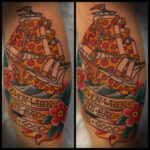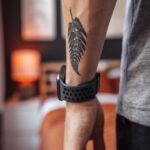The world of tattooing is filled with varied techniques and strong opinions, and the debate between “riding the tube” versus “working off the needle” is a prime example. While some artists advocate for “riding the tube” as a matter of personal preference, it’s crucial to consider the potential downsides, especially when aiming for the best results and minimizing trauma to the skin. For those new to tattooing or looking to refine their technique, understanding why “riding the tube” can be a less desirable approach is essential. This article will explore the reasons why “riding the tube” can increase the risk of skin complications, potentially leading to issues like Tattoo Torn Skin, and why focusing on needle visibility offers greater control and safer tattooing practices.
The Mechanics of “Riding the Tube” and Potential Pitfalls
“Riding the tube” refers to a tattooing technique where the artist relies on the tattoo tube as a visual guide, moving it across the skin to create lines. While seemingly straightforward, this method introduces several risks that can compromise the quality of the tattoo and, more importantly, the integrity of the skin.
The Risk of Skin Bunching and Tearing
One of the primary concerns with “riding the tube” is the increased likelihood of skin bunching. As the tube, often made of metal or plastic, is dragged across the skin, it can push and pull the delicate surface. Even with lubricants, the friction and movement can cause the skin to compress and fold, particularly in areas with loose skin or curves.
Alt text: Close-up of a tattoo machine setup showing the tube and needle, highlighting the potential for the tube to drag on the skin.
This bunching effect has several negative consequences:
- Inconsistent Needle Depth: When skin bunches, the depth of needle penetration becomes erratic. In some areas, the needle might be forced too deep as the skin folds, while in others, it might be too shallow. This inconsistency is a direct path to uneven lines and potential skin damage.
- Increased Trauma and Risk of Torn Skin: The act of bunching and dragging can stress the skin beyond its natural elasticity. This mechanical stress, combined with the trauma of the needles, elevates the risk of tearing the skin, especially in sensitive areas. Tattoo torn skin is not only painful for the client but also detrimental to the final tattoo appearance and healing process.
- Snagging and Uneven Lines: As the tube moves across bunched skin, it can snag or catch, leading to jerky movements and broken lines. This lack of smooth, controlled motion makes it challenging to create clean, crisp lines, a fundamental aspect of quality tattooing.
Obstructed Vision and Lack of Precision
“Riding the tube” inherently obstructs the artist’s direct view of the needles interacting with the skin. By focusing on the tube’s position, the artist loses the crucial visual feedback of the needle itself.
Alt text: Tattoo artist concentrating on the tattoo tube while working, illustrating the obstructed view of the needle and skin.
This limited visibility creates several disadvantages:
- Guessing Needle Placement: Without a clear line of sight to the needle tip, artists are essentially guessing their precise needle placement. Factors like rubber band shifts, machine vibrations, and slight hand movements can throw off this estimation, leading to inaccuracies in line work.
- Difficulty Judging Depth: Accurate needle depth is paramount for preventing tattoo torn skin and ensuring proper ink implantation. Riding the tube makes it significantly harder to judge and maintain consistent depth, increasing the risk of blowouts (ink spreading under the skin) or shallow, faded lines.
- Compromised Control: Tattooing demands fine motor control and precise movements. Obstructing the view of the needle reduces this control, making it more challenging to execute intricate designs or subtle variations in line weight.
Mess and Skin Irritation: Additional Stress on the Skin
The physical act of dragging the tube across the skin while “riding the tube” can exacerbate messiness during the tattoo process.
- Ink Pooling and Excessive Wiping: The tube’s movement can push ink around, creating pools that obscure the working area. This necessitates more frequent wiping to maintain visibility.
- Increased Skin Irritation: Excessive wiping, while necessary for visibility when “riding the tube,” contributes to skin irritation. Repeatedly wiping the tattooed area, especially during longer sessions, can further stress the skin, making it more susceptible to damage and potentially increasing the risk of tattoo torn skin. Irritated skin is also less receptive to ink, potentially affecting color saturation and healing.
Working Off the Needle: A Technique Focused on Skin Health and Precision
In contrast to “riding the tube,” “working off the needle” emphasizes direct visual control of the needle and its interaction with the skin. This technique prioritizes needle visibility and precise movements, minimizing skin trauma and promoting cleaner, more controlled tattooing.
Alt text: Tattoo artist focusing intently on the needle while tattooing, demonstrating the “working off the needle” technique for precision.
By focusing on the needle, artists can:
- Maintain Consistent Needle Depth: Directly observing the needle allows for precise depth control, minimizing the risk of going too deep and causing tattoo torn skin or blowouts, or too shallow and resulting in faded lines.
- Achieve Smooth, Controlled Lines: Visual feedback from the needle enables smoother, more deliberate movements, leading to cleaner, crisper lines and greater accuracy in design execution.
- Reduce Skin Trauma: Working with precision and avoiding unnecessary dragging and bunching minimizes mechanical stress on the skin, reducing irritation and the risk of tearing.
Conclusion: Prioritizing Skin Integrity and Technique
While personal preferences exist in tattooing, certain techniques inherently carry more risks than others. “Riding the tube,” while perhaps seemingly easier initially, introduces several factors that can compromise tattoo quality and, importantly, increase the risk of skin damage, including tattoo torn skin.
For artists striving for excellence and prioritizing client comfort and skin health, “working off the needle” offers a more controlled, precise, and ultimately safer approach. Mastering this technique may require more initial effort, but the benefits in terms of tattoo quality, skin integrity, and client satisfaction are undeniable. Embracing techniques that minimize skin trauma is crucial for responsible tattooing and achieving consistently outstanding results.

